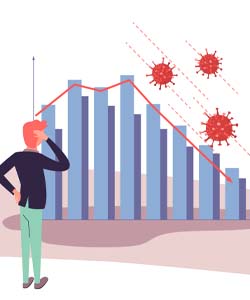Subscribe for Weekly Updates

The Demographic Squeeze Has Arrived in Pennsylvania
By Matthew Knittel
In October 2022, the Commonwealth of Pennsylvania’s Independent Fiscal Office published an updated demographics forecast for the state through 2030. The office publishes projections each year as part of its annual five-year economic and budget outlook report. While the latest projections are similar to prior years, the pandemic exacerbated certain long-term trends that, unless reversed, will have a negative impact on economic growth. Specifically, a pandemic-induced contraction in labor force participation rates reinforced negative demographic trends, creating a labor market that has never been tighter or more challenging for employers.
 A look at the demographic trends for the last three years (2019-2022) and the next three years (2022-2025) illustrates the challenges. For those two time periods, the estimated change in population across the four primary age groupings are as follows:
A look at the demographic trends for the last three years (2019-2022) and the next three years (2022-2025) illustrates the challenges. For those two time periods, the estimated change in population across the four primary age groupings are as follows:
- Under age 25 (down 72,000 for 2019-2022; down 59,000 for 2022-2025)
- Age 25-54 (down 63,000; down 46,000)
- Age 55-64 (down 75,000; down 96,000)
- Age 65 or older (up 174,000; up 197,000)
From 2022 to 2025, the state population will remain stagnant, with a modest net migration inflow (largely due to international migration) offset by organic contraction (i.e., the number of deaths exceeding births). These near-term demographic projections are generally reliable due to the stability of birth, death, and migration rates.
Prior to the pandemic, the demographic trends had raised concern because they suggested that the labor force would contract while simultaneously there would be an increased demand for services for older residents. The pandemic exacerbated those trends because many residents left the labor force. The latest data show that state labor force participation rates (the share of adults working or looking for work) remain well below prepandemic rates (down 1.3 percentage points). Labor demand now far exceeds labor supply. The September unemployment rate (4.1% seasonally adjusted, 3.4% nonseasonally adjusted) was the lowest rate since state data began being published in 1976.
The impact has become apparent in the large contraction of the state labor force compared with prepandemic levels. The labor force includes all workers and those actively seeking employment. From September 2019 to September 2022, the state labor force contracted by 120,000 individuals. For various reasons, fewer working-age adults now want or need employment. Factors could include increased savings or wealth accumulation, caring for elderly parents, increased popularity of home or cyberschooling, on-going health issues (e.g., long COVID), and extended federal emergency declarations (e.g., the vertical SNAP benefits cliff). The IFO estimates that roughly one half of the labor force contraction could be due to the reasons listed above. Another factor is the long-term demographics trend: flat population growth and an aging population where older residents have much lower labor force participation rates. For the United States (state data is not available), labor force participation rates in October 2022 were as follows:
- Age 25-54 (82.7% participation)
- Age 55-64 (65.1%)
- Age 65-69 (35.1%)
- Age 70-74 (18.9%)
- Age 75 or older (8.2%)
Therefore, the normal aging of the state population will, by itself, cause overall labor force participation rates to contract.
Prior to the pandemic, the Pennsylvania economy generated an average of 50,000 payroll jobs (excluding the self-employed) each year. Assuming an unemployment rate of 5%, the labor force participation rate would need to increase by nearly 1.0 percentage point in 2023 to generate a supply of labor that facilitates the creation of 50,000 new payroll jobs. In each succeeding year, the rate would need to continue to increase an additional 0.5 to 0.7 percentage points to supply sufficient labor to facilitate the annual creation of 50,000 payroll jobs. This type of rate pattern has never occurred since data have been published.
Other states face similar challenges, but the outlook may be less stark if the state population is not as old as it is in Pennsylvania, has population growth (largely through net migration), or had a smaller contraction in the labor force participation rate (and labor force) due to the pandemic. For Pennsylvania, the confluence of an aging population, stagnant population growth, and on-going pandemic related impacts implies significant challenges for economic growth and the state budget.
Matthew Knittel has served as director of the Pennsylvania Independent Fiscal Office since its creation in 2011. Prior to his tenure, he was a financial economist for the U.S. Treasury Department and Michigan Department of Treasury. He received a PhD in economics from Michigan State University.
Sign up for weekly professional and technical updates from PICPA's blogs, podcasts, and discussion board topics by completing this form.







Leave a commentOrder by
Newest on top Oldest on top